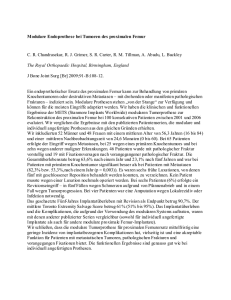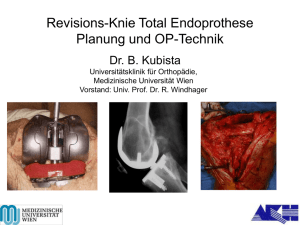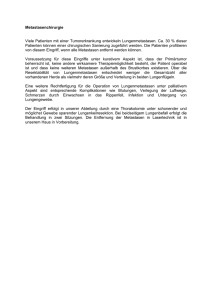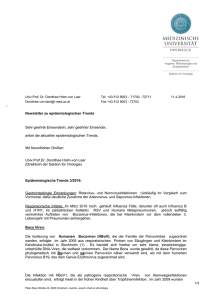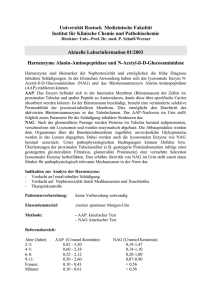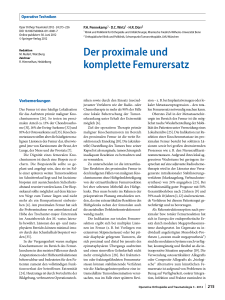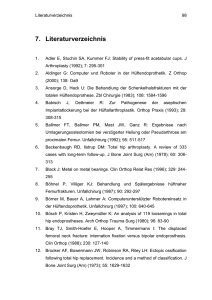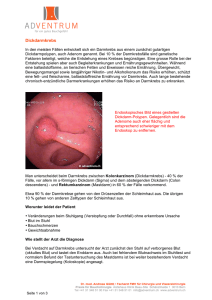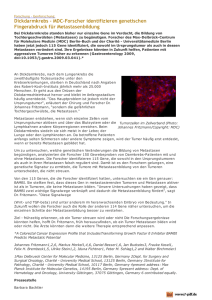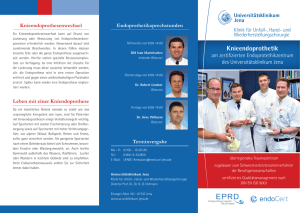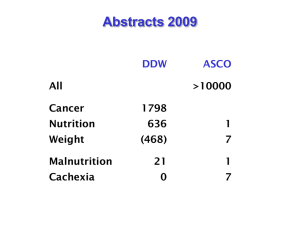Behandlung von Metastasen langer Röhrenknochen
Werbung
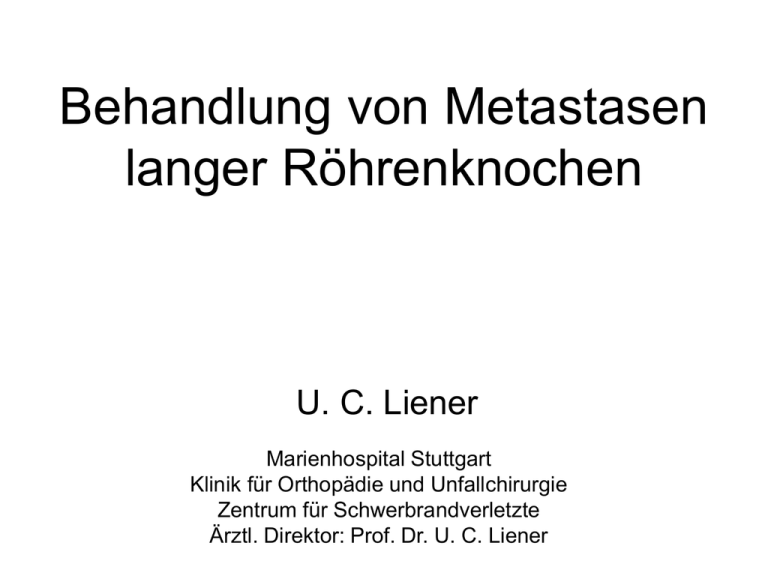
Behandlung von Metastasen langer Röhrenknochen U. C. Liener Marienhospital Stuttgart Klinik für Orthopädie und Unfallchirurgie Zentrum für Schwerbrandverletzte Ärztl. Direktor: Prof. Dr. U. C. Liener Metastasen • Klinik und Diagnostik • Lokalisation • Indikation • Operative Verfahren Klinik und Diagnostik • Schmerzen (Winchester, Cancer, 1979) • Nachts, Ruhe, Belastung • Überwiegend Femur (Harrington, Instr Course Lec, 1977) • Hyperkalziämie (Coleman, Cancer, 1997) • Myelom Screening (Rougraf, JBJS(A), 1993) • Tumormarker, Staging (Knochenszintigraphie...) • Initiale Biopsie Lokalisation (n=584) HWS Schultergürtel prox. Humerus Humerusschaft EG-Region Unterarm BWS LWS Becken prox. Femur Femurschaft dist. Femur Tibia Sonstige 0 50 Fraktur 100 Metastase 150 200 Fraktur und Primärtumor Mammacarzinon (gemischt) 56% Nierenzellkarzinom (lytisch) 11% Multiples Myelom (lytisch) 10% Bronchialkarzinom 9% Protatakarzinom (blastisch) 4% Habermann, n= 283, Clin Orthop 1982 Metastasen Solitäre Metastasen 9% Knochenmetastasen Zeichen einer fortgeschrittenen Tumorerkrankung Prognose Wedin, Acta Orthop Scand, 2001 Therapieziele • Funktionserhalt (Mobilität) – Vermeidung von Frakturen – Stabilisierung von Frakturen • Pflegeerleichterung • Schmerzreduktion • keine Lebensverlängerung ! Interdisziplinarität • Patient muss in Gesamtkonzept eingebunden sein • Tumorkonferenz, Tumorzentrum • Präoperativ Embolisation • Postoperativ Radiatio • Adjuvante Chemotherapie • Bisphosphonate Präoperative Emblisation • • • • Nierenzell-Karzinom Schilddrüsen-Karzinom Plasmozytom Riesenzelltumor konservative Therapie „ unsatisfactory, producing limited use, incomplete pain relief and unpredictable healing“ Flemming, Clin Orthop, 1986 Indikation und Strategie Kyle, JAAOS, 2000 Scoring nach Mirels 1 Lokalisationobere Extr.untere Extr. Schmerzen Typ Größe 2 3 pertrochanter gering mäßig Funktion blastisch lytisch gemischt <1/3 1/3- 2/3 >2/3 Mirels, Clin Orthop, 1989 Frakturwahrscheinlichkeit Mirels, Clin Orthop, 1989 Verfahren Prophylaktische Stabilisierung Verfahren • Osteosynthesen Extramedullär (Platten) Intramedullär (Nägel) Kombination (DHS, DMS) • Verbundosteosynthesen Implantat + Zement • Endoprothesen Operative Verfahren • Primär langstreckige, stabile Implantate • Bevorzugt minimalinvasiv intramedullär • Stabile Implantatverankerung • Primäre Indikation zur Endoprothese erwägen Komplikationen Implantatlockerung Implantatbruch Refraktur Fokal Parafokal Infektion Fischer, Dissertation, 2002, n=112, 17,8% Implantatversagen Wedin, Acta Orthop Scand, 2001 Implantatversagen Wedin, Acta Orthop Scand, 2001 Proximales Femur • • • • Häufigste Lokalisation Endoprothese gute Ergebnisse (Lane, JBJS(A), 1980) Verbesserung des Transfer Begleitende Läsionen im Azetabulum (Harrington, Clin Orthop, 1982) Vollprothese vs. Duokopf • Intertrochanter Implantatversagen Proximaler Femurersatz Endoprothese • Zementierte Standardprothesen • Zementierte Spezialprothesen Tumorprothesen Diaphysenprothesen Modulare Systeme Kompletter Knochenersatz Individualanfertigungen Strategie Humerus • 2. häufigste Frakturlokalisation • Einschätzung nach Mirels • Proximal Prothese • Diaphysär Nagel/ Platte • Distal Platte Reha? „ most patients with a pathologic fracture will survive for at least 1 to 6 months depending on the primary cancer. Because this time is limited, it is precious. “ (Bunting, Clin Orthop 1995)
